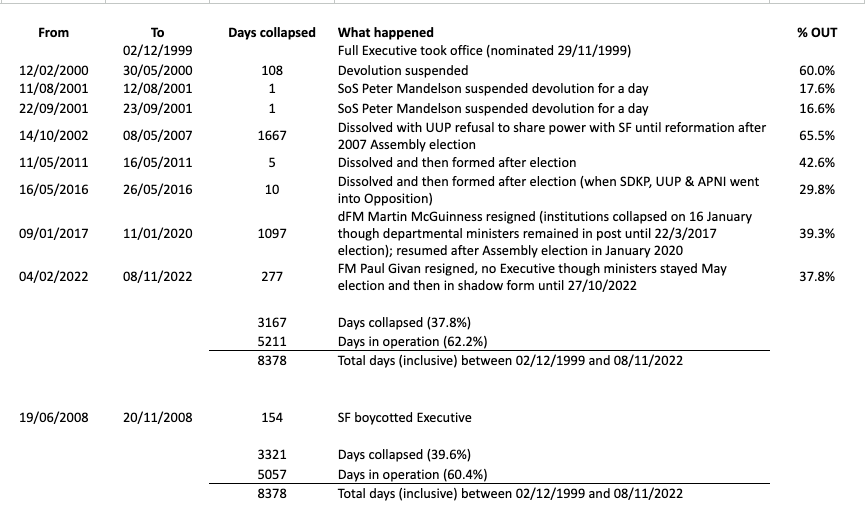- FactCheckNI has counted the days of existence and days of dysfunction.
- The Executive has been utterly collapsed for around 37.8% of that time.
- However, that rises to 39.6% with the six-month Sinn Féin boycott in 2008 – which rounds up to 40%.
***UPDATE FOR 28 JULY 2023: Since this fact check was published, another 262 days have passed – all without a functioning Executive.
That takes the total number of collapse days for modern Stormont up to 3578 (3316 days, including the 2008 Sinn Fein boycott, plus a further 262) while the number of working days remains on 5057.
As of today, Stormont has been in a state of collapse for 41.5% of its existence.***
On Thursday 27 October’s BBC Radio Ulster Talkback programme programme (17:58), the claim was made that “since the Good Friday Agreement, we have had an Assembly that has collapsed 40% of the time of its entire existence”.
A briefing issued in September by the Pivotal public policy think tank stated: “Since devolution in 1999, the Executive has not been functioning for more than 40% of the time.”
An article in Saturday 29 October’s Irish Times quoted an academic who “has done the sums; since their formation, the power-sharing institutions have been out of operation nearly 37 per cent of the time,” adding that being suspended for “46 per cent of the time” in the most recent five years is “almost as bad as the first five years, at 49 per cent missing in action”.
The most recent incarnation of the Northern Ireland Executive began when ministers took office on 2 December 1999.
In the 8378 days since then, there have been 5057 days of operation, 3167 days of suspension, and a further 154 days of boycotts leaving it unable to function.
If both dissolution and periods of boycott are considered, the Executive has effectively been collapsed 39.6% of the time.
So, yes, it is accurate to say that the Executive has been collapsed for 40% of its existence – and rising.
- When did the Northern Ireland Executive come into being?
History buffs will remember the short-lived Northern Ireland Executive established on 1 January 1974 following the Sunningdale Agreement, but which collapsed that same year on 28 May.
In more recent times, following the Belfast/Good Friday Agreement and the referendums, the Northern Ireland Executive and Assembly were established by law by the Northern Ireland Act 1998. It was later revised by the Northern Ireland (St Andrews Agreement) Act 2006.
First Minister designate (David Trimble) and deputy First Minister designate (Seamus Mallon) were appointed on 1 July 1998. However, it wasn’t until 29 November 1999 – seventeen months later – that the d’Hondt process was run to nominate the remaining Executive ministers. They officially took office three days later.
- When has the NI Executive been unable to meet?
We’ve chosen to look at the vital statistics of the ‘Executive’ (the collection of departmental ministers, junior ministers and First and deputy First Ministers) rather than the ‘Assembly’ (the devolved legislature of MLAs).
The dates of formation and dissolution of the Executive are one thing. The days on which the Executive could physically meet – since both the First Minister and deputy First Minister need to be in post and willing to attend – are another.
The resignation of deputy First Minister Martin McGuinness on 9 January 2017 triggered the formal collapse of the Stormont institutions a week later on 16 January 2017.
Between the 2 December 1999 and today (8 November 2022) when this article was published, the Executive has been affected by the following events:
- devolution was suspended between 12 February 2000 and 30 May 2000;
- Secretary of State Peter Mandelson suspended devolution for a day on 11 August 2001 and again on 22 September 2001;
- dissolved on 14 October 2002 until its formation four and a half years later on 8 May 2007 after an election that followed the October 2006 St Andrews Agreement;
- dissolved for a few days between 11 and 16 May 2011 for an election;
- dissolved for a few days between 16 and 26 May 2016 for an election;
- dissolved on 16 January 2017, a week after the resignation of deputy First Minister Martin McGuinness on 9 January 2017 (though ministers remained in office until the election on 22 March 2017) and only formed again on 11 January 2020;
- dissolved when First Minister Paul Givan resigned on 4 February 2022 (though departmental ministers remained in shadow form until 27 October).
- Scores on the doors
So between 2 December 1999 and 8 November 2022 (inclusive), the Executive has been working for 5211 days and suspended for 3167. By FactCheckNI’s calculation, it has been suspended for 37.8 per cent of its existence … and maybe a little more.
The Executive was also not able to meet for a period of 154 days between 19 June and 20 November 2008 when Sinn Féin ministers carried out a boycott. That would boost the proportion of time suspended to 39.6 per cent of the Executive’s lifetime – which, with normal rounding up, is perfectly fair to call 40%.
In 2015, between 8 September and 20 October DUP ministers (Jonathan Bell, Simon Hamilton, Michelle McIlveen and Mervyn Storey repeatedly resigned for a few days at a time before being reappointed for a short period. We haven’t taken this period into account as none of these rotating ministerial appointments would have technically prevented the Executive from meeting as the First and deputy First Ministers were in place, albeit Arlene Foster was acting as First Minister between 11 September until 20 October when Peter Robinson resumed the office.
Note that the percentage of time the Executive has been suspended (or not meeting) will continue to rise through to the end of 2022 and potentially into 2023 in the absence of an Assembly Speaker that is blocking the nomination of First and deputy First Ministers and the running of d’Hondt to nominate the other ministerial positions.
If this article had been written on 8 May 2007, it would have found that the Executive had been out of operation for nearly two thirds of its existence (65.5%).
Regarding the calculation in the Irish Times that the institutions were suspended 49 per cent of the time in their first five years and 46 per cent in the last five years, the most recent figures are a bit of an understatement.
FactCheckNI calculates that between 2 December 1999 and 2 December 2004, the Executive was in operation for 937 days and down for 890 (48.7 per cent). And between 8 November 2017 and 8 November 2022, the Executive has been up for 755 days and suspended for 1071 days (58.7 per cent). So the most recent five years of Executive operation has in fact been worse than the first five years of its existence.
Identifying the days when the Executive was incapable of meeting is not straightforward. FactCheckNI welcomes receiving further evidence on this or any of our articles, whether it refutes or validates our conclusions.






